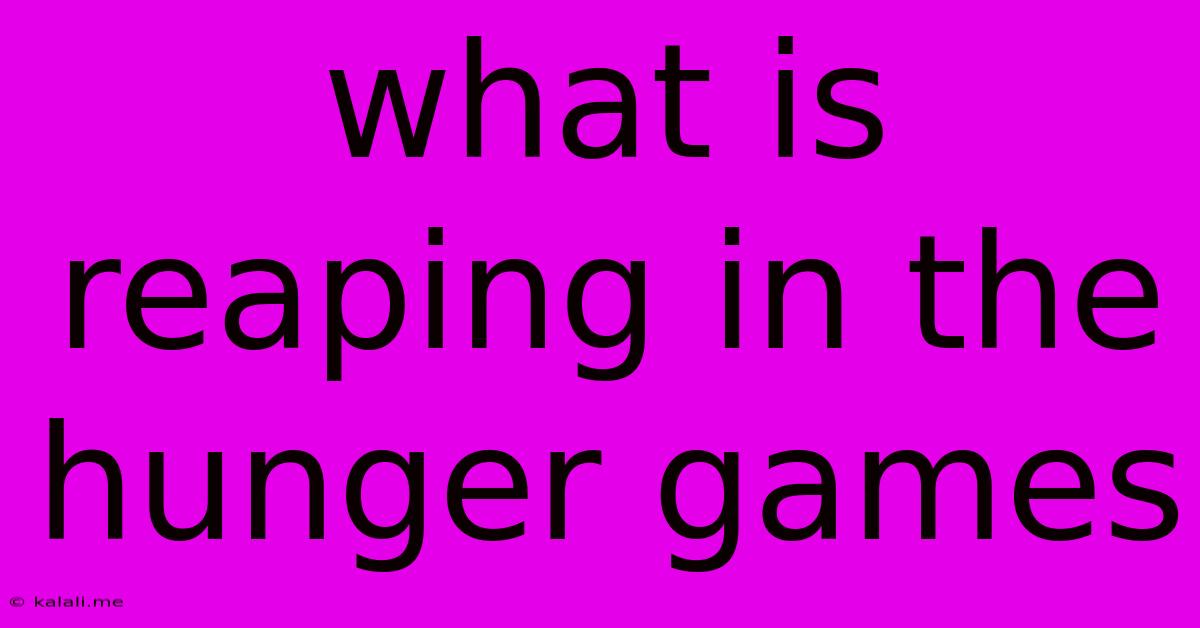What Is Reaping In The Hunger Games
Kalali
Jun 08, 2025 · 3 min read

Table of Contents
What is Reaping in The Hunger Games? Understanding the Brutal Lottery of Panem
The Hunger Games, Suzanne Collins' dystopian masterpiece, hinges on a chilling annual ritual: the Reaping. This isn't a simple lottery; it's a meticulously orchestrated display of power, fear, and societal control. Understanding the Reaping is crucial to grasping the very core of Panem's oppressive regime and the rebellion it sparks. This article delves deep into the mechanics, symbolism, and societal impact of the Reaping.
What exactly is the Reaping? In essence, the Reaping is the annual selection of children – one boy and one girl – from each of Panem's twelve districts to participate in the Hunger Games. These children, aged 12 to 18, are chosen at random through a lottery system. The selection process is a terrifying spectacle, designed to instill fear and remind the districts of the Capitol's absolute power. This public execution, broadcast across Panem, serves as a constant reminder of the price of rebellion.
The Lottery System: Odds and Inequality
The lottery system itself isn't fair. Wealthier families can afford to purchase tesserae – extra entries into the Reaping – in exchange for meager food rations. This means that children from impoverished families, like Katniss Everdeen's, have a significantly higher chance of being selected. This inherent inequality is a deliberate tool used by the Capitol to maintain control and suppress any potential uprising. The desperation caused by poverty and hunger directly contributes to the high stakes of the Reaping. It's not just a random lottery; it's a calculated gamble rigged against the poor.
The Reaping Ceremony: A Spectacle of Fear
The Reaping itself is a carefully orchestrated event, a theatrical production designed to maximize fear and highlight the Capitol's dominance. It involves a public gathering in the town square, where the names are drawn one by one. The suspense, the screams, the visible terror etched on the faces of the children and their families – all of these contribute to the event's chilling impact. The ceremony is broadcast live throughout Panem, a constant reminder of the Capitol's power and the districts' subjugation. This public display of fear and suffering serves to further the Capitol's control and prevent rebellion.
Symbolism and Social Commentary
The Reaping is far more than a simple selection process; it's a powerful symbol. It represents:
- Oppression and Control: The Reaping embodies the Capitol's ruthless control over the districts, maintaining order through fear and violence.
- Inequality and Poverty: The tesserae system exacerbates the already vast inequality between the wealthy and the poor, highlighting the Capitol's callous disregard for the lives of the impoverished.
- The Brutality of the System: The Reaping is a stark reminder of the inhumanity of Panem's regime and the sacrifices demanded of its citizens.
- Hope and Rebellion: While terrifying, the Reaping also inadvertently fuels rebellion. The sheer injustice of the system inspires defiance, eventually culminating in the uprising depicted in the later books.
The Reaping in The Hunger Games is far more than just a plot device; it's a crucial element of the story's social commentary, reflecting real-world issues of inequality, oppression, and the human capacity for both brutality and resilience. It's a chillingly effective tool used to maintain control, but also a catalyst for the rebellion that ultimately challenges the Capitol's authority.
Latest Posts
Latest Posts
-
My Little Pony Friendship Is Magic Spike
Jun 08, 2025
-
Trek Marlin 5 Tire Tube Keeps Leaking
Jun 08, 2025
-
Can You Put Oil Based Paint Over Latex Paint
Jun 08, 2025
-
How Do You Pluralize A Name Ending In S
Jun 08, 2025
-
How To Remove Tub Spout With Diverter
Jun 08, 2025
Related Post
Thank you for visiting our website which covers about What Is Reaping In The Hunger Games . We hope the information provided has been useful to you. Feel free to contact us if you have any questions or need further assistance. See you next time and don't miss to bookmark.